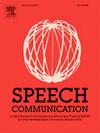Non-native (Czech and Russian L1) auditor assessments of some English suprasegmental features: Prominence and pitch accents
IF 3
3区 计算机科学
Q2 ACOUSTICS
引用次数: 0
Abstract
This study reports on a comparative perceptual experiment investigating the ability of Russian and Czech advanced learners of English to identify prominence in spoken English. Two groups of non-native annotators completed prominence marking tasks on English monologues, both before and after undergoing a 12-week phonological training program. The study employed three annotation techniques: Rapid Prosody Transcription (RPT), traditional (British), and ToBI. While the RPT annotations produced by the focus groups did not reach statistical equivalence with those of native English speakers, the data indicate a significant improvement in the perception and categorization of prominence following phonological training. A recurrent difficulty observed in both groups was the accurate identification of prenuclear prominence. This is attributed to prosodic transfer effects from the participants’ first languages, Russian and Czech. The study highlights that systemic, phonetic, and distributional differences in the realization of prominence between L1 and L2 may hinder accurate perceptual judgments in English. It further posits that Russian and Czech speakers rely on different acoustic cues for prominence marking in their native languages, and that these cue-weighting strategies are transferred to English. Nevertheless, the results demonstrate that targeted phonological instruction can substantially enhance L2 learners’ perceptual sensitivity to English prosody.
非母语(捷克语和俄语)听者对一些英语超分段特征的评估:突出音和音高口音
本研究报告了一项比较知觉实验,调查了俄罗斯和捷克高级英语学习者识别英语口语突出部分的能力。两组非母语注释者在接受为期12周的语音训练计划之前和之后完成了英语独白的突出标记任务。该研究采用了三种注释技术:快速韵律转录(RPT)、传统(英式)和ToBI。虽然焦点小组产生的RPT注释与母语为英语的人的注释在统计上没有达到相等,但数据表明,经过语音训练后,突出音的感知和分类有了显着改善。在两组中观察到的一个反复出现的困难是准确识别核前突出。这归因于参与者的母语俄语和捷克语的韵律迁移效应。本研究强调,第一语言和第二语言在实现突出性方面的系统、语音和分布差异可能会阻碍英语准确的感知判断。它进一步假设说俄语和捷克语的人依靠不同的声音线索在他们的母语中进行突出标记,并且这些线索加权策略被转移到英语中。然而,研究结果表明,有针对性的语音教学可以显著提高二语学习者对英语韵律的感知敏感性。
本文章由计算机程序翻译,如有差异,请以英文原文为准。
求助全文
约1分钟内获得全文
求助全文
来源期刊

Speech Communication
工程技术-计算机:跨学科应用
CiteScore
6.80
自引率
6.20%
发文量
94
审稿时长
19.2 weeks
期刊介绍:
Speech Communication is an interdisciplinary journal whose primary objective is to fulfil the need for the rapid dissemination and thorough discussion of basic and applied research results.
The journal''s primary objectives are:
• to present a forum for the advancement of human and human-machine speech communication science;
• to stimulate cross-fertilization between different fields of this domain;
• to contribute towards the rapid and wide diffusion of scientifically sound contributions in this domain.
 求助内容:
求助内容: 应助结果提醒方式:
应助结果提醒方式:


